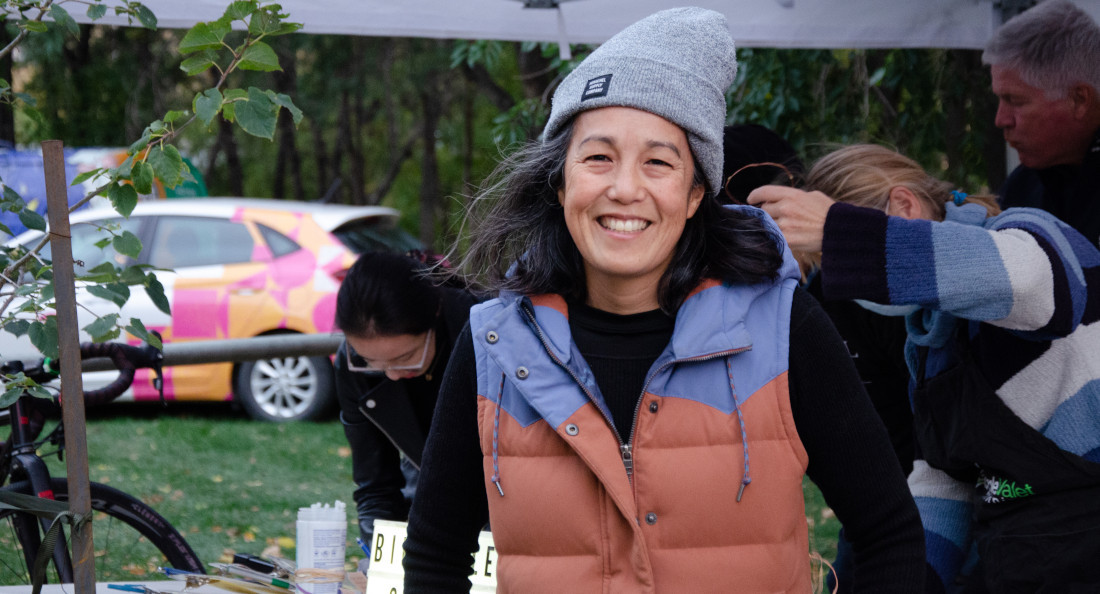Where arts and active transportation intersect
Infrastructure provides opportunities for collaboration
Winnipeg holds many intersections of arts and active transportation. Monthly events like Bike Jam bring together arts, community and physical activity in tandem with events like the Rainbow Trout Music Festival. Murals, supported by the Wall-to-Wall Mural & Culture Festival, bring life to grocery stores and concert-venue exteriors, allowing pedestrians to experience art.
Creating literal and figurative pathways toward active transportation isn’t just about road infrastructure. Stephanie Chow, the project manager for Bicycle Valet Winnipeg, knows this. For years, the program has encouraged active transportation to events by offering a safe and secure valet service for cyclists and more.
“The real idea of the bike valet is that it allows events to hire us and to provide a service to encourage people to take active transportation,” Chow says.
The bicycle valet program has been a staple of Winnipeg Blue Bomber games for 11 years. Once the stadium developed their own valet program, Chow says David Wieser, who started the program, donated the racks to Bike Winnipeg to use at events across the city. To date, Chow says the valet, supported by a team of volunteers, has never had a bike stolen.
Today, the program pops up at various festivals and events around the city, like the Downtown Winnipeg BIZ’s Patio Fest and Interstellar Rodeo. Aside from offering a free and feasible way for folks to get to and from events actively, Chow says it demonstrates how alternate methods of transportation can greatly alleviate the dreaded congestion of cars.
“One time, we parked bikes here at The Forks, leaving Interstellar Rodeo for the Beck concert, and there were 300 bikes parked,” Chow says. “We got them out in about 20 minutes, but you can also imagine what 300 vehicles or 200 vehicles would be like.”
The benefits of active transportation are vast. Aside from promoting a healthy lifestyle, it can reduce traffic congestion, increase road safety and improve air quality. After the initial costs of purchasing a bike, scooter or skateboard, it’s remarkably cheap.
In the face of the climate crisis, some experts have suggested that a significant shift toward active transportation is needed. While Winnipeg’s roads aren’t always the most accommodating to cyclists and pedestrians, the development of the Southwest Transitway and advocacy work from groups like Bike Winnipeg bring hope for safer alternatives to driving.
Active transportation has definitely made its mark in Winnipeg. In 2020, open streets across the city allowed pedestrians and cyclists to take back the streets. Protected bike lanes, like the one that now accompanies Westminster Avenue in Wolseley, continue to emerge in central Winnipeg.
With more folks eager to leave the house, organizations like the Winnipeg Arts Council (WAC) have found ways to meld a passion for the arts with a commitment to promoting active transportation. The ArtWalk and ArtRide tours offer Winnipeggers an opportunity to experience and learn about public art as pedestrians or by bike.
“There’s so many different ways to experience public art, and I think the meaning really shifts depending on who is interacting with it, when and what has brought them to the public space,” tamara rae biebrich, the senior project manager of public art at the WAC, says.
Complementing existing activetransportation infrastructure has also been a feature of the program. A tour down the Southwest Transitway provides opportunities for folks to learn about local history and converse about public artworks. In the six-kilometre stretch, biebrich says seven art installations can be encountered along the way.
“The collaboration that we did along the active-transportation path with the development of the Southwest Rapid Transitway, or BLUE line, is really exciting, because that is such a big active-transportation path,” they say. “You see so many people on it all the time.”
Some highlights include Ian August’s Rooster Town Kettle, representing the displaced, urban Métis road-allowance community, as well as a collaborative project titled Along the Creek that allows viewers to learn about the Seven Sacred Teachings of the Annishinaabe while enjoying the beauty of the Bunn’s Creek Trail.
Best of all, biebrich says, are the conversations and connections that emerge throughout the duration of the tour.
“Everybody brings their own ideas to their experience of public art in public space, and so tours are an opportunity to learn about the artist’s intention, but also to share your ideas and to talk to your neighbours about why this work is here and what it means to you,” they say.
The experience, however, doesn’t stop at the scheduled tours. With a mobile app released by the WAC called the Winnipeg Public Art Works App, Winnipeggers can make a publicart pit stop on their travels through the app’s map directions, background information and audio commentary from the artists themselves.
The app “helps to inspire you with some ideas for destinations, and maybe gets you into a part of the city or neighbourhood that you’re not familiar with,” biebrich says.
During Nuit Blanche (Sept. 25 to Oct. 3), more public-art installations will be available for viewing with support from the WAC, including a giant inflatable entitled See Hear Speak by artist Paul Robles.
For organizations like Bicycle Valet Winnipeg and the WAC, pairing events, arts and active transportation is a labour of love toward alternatives to cars. As with most things in life, the arts offer a beacon of hope, opening pathways for collaboration between art, history and connection through movement.
ArtWalk and ArtRide tour dates can be found by visiting winnipegarts.ca/ guidedpublicarttours. The Winnipeg Public Art Works App is available to download through the App Store and Google Play.
Published in Volume 76, Number 4 of The Uniter (October 1, 2021)







